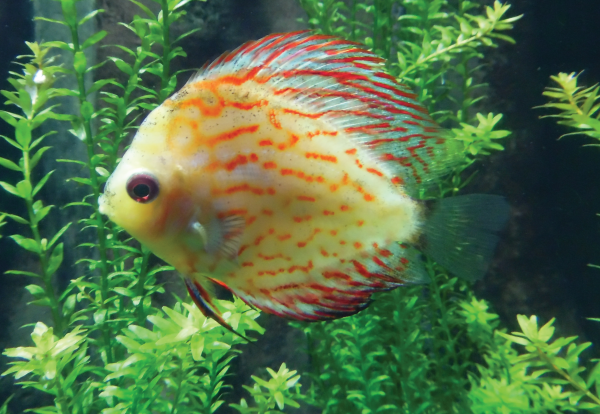

Photo Credit / Briana Magistro
By Briana Magistro
SC Staff Writer
I’m sure you’ve heard the phrase “there are plenty of fish in the sea.” From great big sharks to tiny sardines, this common saying is not wrong.
Forgotten, however, are the many fish of the rivers, lakes, and streams. Here, there is even more diversity.
From feisty piranhas to timid trout, there are thousands of kinds of fish living in fresh water. One of the most diverse and colorful of these is the discus fish.
The discus fish genus includes three different species, each varying in colors and localization.
All three species live in the Amazon River in South America, although they inhabit different areas. Together, the species range across parts of Peru, Columbia, and Brazil.
These species tend to live in floodplains or lowland areas of the Amazon, where there is plentiful greenery to sustain neotropical life.
Other neotropical fish, or those that live right around the equator in Central and South Americas, include angelfish and over 5,000 other species.
The three recognized species of discus fish vary in coloration. Typically, the species are brownish-yellow, blue and red, or turquoise and green. However, it has been noted that some species will mingle and form hybrids of various colors and markings.
Wild-type discus fish have many different patterns. The brownish-yellow fish are mostly yellow with light brown patterns and a large black vertical stripe.
The blue and red fish are almost always solid blue with red fins.
The turquoise and green fish are blue with bright turquoise oval-shaped stripes.
All three species have a compressed shape and are flat. If you look at it head on, you would only see a thin, tall face looking at you! This shape helps them move swiftly through the water. Their dorsal fins are feather-like and are close to the body, giving them that round discus shape.
In the wild, discus fish feed on insects and plankton, which are readily found in the Amazon waters. In captivity, these fish can be fed tropical fish flakes and brine shrimp.
Small schools of discus fish may form, but breeding pairs become territorial of their nesting site.
When breeding occurs, both parents assist in creating a suitable nest, which is usually found around a submerged tree root or sunken branch. Both parents secrete a nutritional “yolk” from their skin to feed the babies after hatching.
Babies stick close to their parents for up to two weeks to feed off of the yolk. The amount of time spent with the parents has been observed to be longer in captivity.
The discus fish can have a wide variety of colorations in the wild, but even more are developing due to captive breeding.
Various colorations and patterns result from hybridization, captive mutation, and diet.
Hybridization occurs when discus fish from different species are bred, and then their offspring is bred.
Mutation is common in captive breeding because of the proximity of other fish and chemicals in the water.
A diet consisting of mainly brine shrimp can cause the fish to have a red-colored undertone. This occurs in many aquatic animals, including flamingos.
Discus fish have been bred for captive use for almost 100 years.
They are common in aquariums because of their colorful appearance and because they can live up to 10 years in captivity.
Home aquariums tend to have less luck than industrial-sized exhibits.
Next time you travel to an aquarium, make sure to visit the fresh water or river exhibits. You will most likely see some beautiful discus fish!
The Adventure Aquarium in Camden, New Jersey, houses the wild-type blue discus. It is the closest place to ESU to see these stunning fish.
Other aquariums, like the Georgia Aquarium in Atlanta, house some of the captive colorations.
Always remember to keep the rivers and oceans clean to support the future of all aquatic life!
Email Briana at:
bmagistro@live.esu.edu
